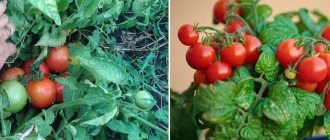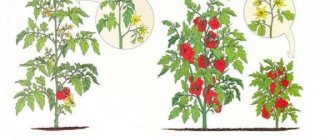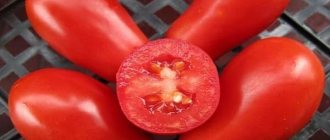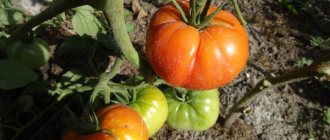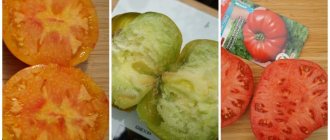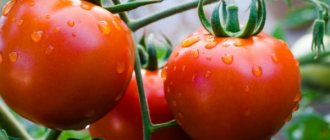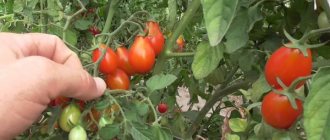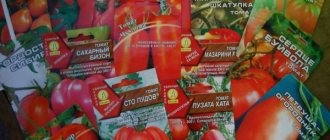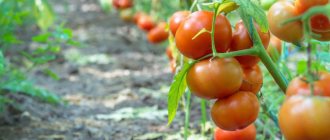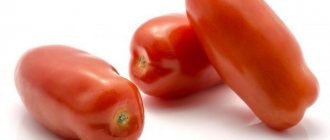High-yielding tomatoes for the northern region
You need to start with a category such as bush height.
There are several types here. All of them are presented in the table below. The next classification concerns the timing of ripening. In the general sense, these are early, middle and late varieties. This characteristic determines where to plant this variety: in the south of the country or the north, in a greenhouse or in open ground.
There are smaller divisions based on ripeness. For example, ultra-early ripening tomatoes. They are characterized by the fact that only 80-85 days pass from the first shoots to ripening, and there are hybrids that ripen in 75 days.
Most often, ultra-early ripening tomatoes include super-determinate tomatoes, which have small and not sweet fruits. They grow in conditions of short daylight hours and are good where the days are correspondingly short. Examples of these could be:
- Cherry flow F1,
- Children's sweetness,
- Lark F1,
- Olya F,
- Sanka.
The next group is early ripening tomatoes. They mature in 90-95 days.
Here you can find both short standard tomatoes and medium-sized determinate varieties. They are suitable for northern regions where the climate is cold and daylight hours are short. These include:
- Redskin Chief (Sugar Buffalo),
- Leopold F1,
- Diva F1,
- The Tsar Bell.
Next come the mid-early varieties. They mature much later. In 100-105 days. They can be planted both in greenhouses and in open ground. If they are grown in open ground, then it is better to place the beds on the south side of the site. Some of the most popular in this category:
- Blagovest F1,
- Loyalty F1,
- Verlioka plus F1,
- Giant of the Moscow region,
- Moscow pear,
- Moscow delicacy.
The next group is represented by mid-season tomatoes. They ripen 115 days after germination. Tomatoes of these types need much more heat and especially light.
They are grown both in greenhouses and in open ground. Their names:
- Budenovka,
- Koenigsberg,
- Kostroma F1,
- Siberian miracle,
- Suitor,
- French grape.
And finally, the last category is late ripening. They ripen for a long time - from 120 to 130 days. They can be grown in open ground only in warm regions; in the middle zone it is no longer recommended. They are ideal for greenhouses. All of them are also tall. Among them:
- Bull's heart
- Vladimir F1,
- De Barao,
- Titanium,
- Date fruit,
- Finish.
These are the so-called main separating characteristics.
And one more category, which is more culinary. Based on the taste qualities and the condition of the fruit (thick-walled or thin-walled, juicy, etc.), only salad varieties can be distinguished, i.e. for fresh, straight from the garden consumption. Also those that are used for preservation and processing, such as lecho, sauces, juices. And there are also universal varieties that can be eaten both fresh and canned.
Universal varieties include:
- Alaska,
- Infiniti F1,
- Pink Andromeda F1,
- Chio-chio-san,
- Shchelkovsky early.
Salad:
- Watermelon,
- Danko,
- Infiniti F1,
- Italian grooved,
- Nadezhda F1.
Varieties for processing:
- Grandma's secret
- Bull's heart
- Budenovka,
- Giant,
- Cardinal,
- Mazarin,
- Mashenka.
For canning:
- De Barao,
- Children's sweetness,
- golden fingers,
- Sanka,
- Lapwing,
- Elf,
- Chocolate bullet.
Based on these characteristics, you can choose exactly the species that you need for planting.
When growing tomatoes in a greenhouse, you need to pay attention to their growth and ripening time. So, it is best to plant early tomatoes only in a greenhouse.
Tall varieties are best planted in greenhouses and greenhouses. This is due to the fact that it will be easier to tie them there during growth. Among them there are quite a lot of fruitful ones. Here are some of them.
Paradise apple
The tomato is mid-early, ripening occurs in 100-105 days. By belonging to growth, it is indeterminate. The fruits are round, pink, fleshy, weighing up to 150-200 g.
The apple of paradise is resistant to both disease and adverse weather conditions. Seeds for seedlings should be sown in March. In general cultivation, picking is done after 1-2 true leaves appear. Feeding of seedlings is carried out by applying a full range of fertilizers.
Tomatoes are planted in heated greenhouses in April, and in unheated film greenhouses only in May, when the plants are 60-65 days old. Plants need to be tied up.
The fruits are consumed fresh.
Alhambra
A high-yielding hybrid with fruits weighing 150-180g, with a ripening period of 110-115 days. There are 4-6 of them on the brush. The yield per bush is up to 6 kg. The plant is indeterminate and is intended for cultivation in any type of greenhouse.
Resistant to diseases and perfectly stored without loss of quality for up to 4 weeks. That is why it is recommended for transportation. The taste is slightly sweet, the flesh is juicy and meaty. The color is bright red.
One hundred pounds
The tomato, like the previous one, is a mid-early indeterminate one, reaching a height of up to 1.8 meters in greenhouses. It goes without saying that a garter is required. The fruits are large, up to 300 g, ripen in clusters of 3-5 pieces.
The fruits do not crack and have a sweet taste. Productivity is up to 9 kg per 1 sq. m.
La-la-fa
It is high-yielding, reaching a height of up to one and a half meters, so it is grown on trellises.
The plant is unpretentious to grow. The fruits are slightly flattened, weighing from 130 to 170 g. They are aromatic in taste, have juicy pulp, and the fruits do not crack.
The fruit ripening period is 100-105 days. Based on this, it is early ripening. The harvest can be harvested from July until autumn. The yield is high, up to 20 kg of fruit can be collected per square meter, and up to 4 kg from one bush. The fruits are used universally, i.e., in salads, canning and juice.
De Barao
De Barao is late-ripening and frost-resistant. The bushes reach a height of up to two and a half meters, but can reach four. The fruits have the shape of a plum, weighing 200 g.
Productivity is up to 3.5 kg per bush. The bush is resistant to diseases, the fruits do not crack and can be stored for a long time.
Cio-chio-san
It is mid-season indeterminate. The bush is branched, and therefore needs a garter. It can reach two meters in height.
The fruits are small, only about 40 g, but up to 50 full-fledged tomatoes can be formed on one brush. As a result, the yield from one bush reaches 4.5 kg. The bush is resistant to diseases.
Wild Rose
A medium-yielding variety, indeterminate, reaches a height of up to 2.5 meters. Accordingly, it is necessary to tie up and step-son. The fruits are large, weighing up to 400g.
Their color is raspberry, the taste is sweet and sour, the pulp is juicy. The yield is up to 3.5 kg per plant.
However, not all gardeners prefer to associate with tall plants. Gartering, making trellises and pegs, pinching - all this is quite troublesome. If this doesn't suit you, try growing low-growing tomatoes.
If you are a fan of small tomatoes, or cherry tomatoes as they are called, then you can grow these little ones yourself in your greenhouse.
Arctic
It is super-early and ripens after 75 days.
The bushes are very small, up to 40 cm. Up to 25 small tomatoes ripen on the inflorescences
Bing cherry
Unlike the previous variety, this one is tall, reaching a height of up to 1.8 m.
The bush is formed into 2-3 stems. It bears fruit until frost; the fruits themselves, colored in several shades: red, pink and lilac, weigh from 50 to 80 g.
Bulls-eye
This tomato is very tall, up to 2 m in height. It is a mid-early plant.
The clusters reach a length of 12 to 40 fruits. Each tomato weighs 30 g. The fruits are beautiful, smooth, red, spherical in shape.
Pear yellow F1
An interesting representative of its species, having yellow and pear-shaped fruits, as its name suggests. The height of the bush reaches up to 2 meters. Ripening occurs after 95 days.
The fruits weigh up to 20 g and have a sweet taste. The trunk and brushes, due to the abundance of the harvest, need a garter.
Thumbelina
Another popular cherry variety. The bushes reach a height of 1.5 m. Ripening occurs after 90 days.
When growing, the bush must be formed into two stems, and all stepsons must be removed. The spherical fruits weigh no more than 20 g. Up to 15 fruits can be removed from one brush, and 5 kg from a square meter.
The climate in the northern regions is quite harsh, and therefore it is necessary to take into account not only the varieties, but also how they will be grown. So, the following are suitable for greenhouse cultivation:
- Polar – is early ripening. Forms 4 clusters with large fruits, shaped like an apple, weighing 150 g.
- Samara F1 is an early ripening tomato. The fruits are dense, smooth, round, weighing 80g. Ripening occurs simultaneously, and therefore the crop is harvested in clusters.
- Tornado F1 - the plant reaches a height of 1.5-1.8 m. The variety is mid-season. The fruits are bright red, round, weighing up to 90 g.
- Taimyr is a fast-ripening crop, a standard bush, fruits weigh from 80 to 100 g. Resistant to low temperatures. After freezing it can produce new shoots and fruits.
Among the fruitful tomatoes I would like to note the following:
- Siberian Troika – fruit weight 100 g. Intended for pickling.
- The joy of summer - a representative of this species is high-yielding and ultra-early. The fruits are elongated, red in color and weighing 100-120 g. Suitable for canning.
- Geisha - has fairly strong bushes up to 70 cm high.
- Pink pearl - fruit weight reaches up to 100g.
- Amur Dawns – you can pick up to 30 fruits from a bush. Suitable for pickling.
These are just a few of the region's productive and popular tomatoes. But in fact, there are quite a lot of them and more.
For the Urals and Siberia, you can also use the varieties discussed in the previous chapter. After all, these regions, especially some of their areas, are located precisely in the northern latitudes. Therefore, here we will look at a few more delicious and wonderful tomatoes.
In the greenhouse conditions of the Urals and Siberia, the following varieties are well suited:
- Siberian early ripening - the fruits ripen early and produce tasty tomatoes weighing up to 110 g.
- Beautiful lady - the fruits weigh up to 150 g. They ripen even under unfavorable conditions. Up to 7 pieces are formed on the brush. The yield per square meter is about 10 kg.
- Miracle of the Earth - the weight of the fruit is up to 380 g, up to 13 kg can be collected per square meter.
- The pride of Siberia is also early, producing sweet fruits weighing up to 900 g.
- The Great Warrior is an early ripening tomato, the fruits weigh about 1.5 kg. The yield is 9 kg per square meter.
- Altai early - fruits reach a weight of 150 g. Productivity is high.
- Grandma's secret is also a high-yielding variety. The weight of the fruit is 350 g. From 1 sq. m. can be collected up to 16 kg.
- Golden Koenigsberg - golden-colored fruits weighing up to 400 g. The taste is similar to apricots.
- King of Siberia is a large-fruited variety. Yellow tomatoes, weighing up to 1 kg.
- Titanic F1 - gives a good high yield of juicy tomatoes.
Productive early and mid-early crops
Some regions of Russia cannot please you with a warm climate. In cold conditions, it is not recommended to grow tomatoes in open ground. A greenhouse or greenhouse is better suited for this purpose.
Experienced gardeners use another proven trick. They grow early ripening tomatoes. Thus, from the moment of planting the seeds to the harvesting of the fruits, 3 months pass.
Lady fingers
Tomatoes of this variety are perfect for canning whole. The fruits are dense and elastic. Yield levels differ between protected and open fields. In shelter, the indicator increases.
Ballerina
Representative of mid-early ripening tomatoes. The culture is a low bush, not exceeding 60 cm. During the flowering season, the shoots are covered with pink flowers. The tomato pulp is juicy and tender at the same time.
Berdsky large
The tomato variety can be characterized in three words - large-fruited, low-growing, early-ripening. The growth of the lashes is limited, their length does not exceed 1 m. One fruit reaches a maximum weight of 700 g. With proper care, the bush produces up to 3.5 kg of fruit.
Ground Gribovsky
It is characterized by high yield when grown in open ground. Tomatoes ripen in waves, weighing about 100 g. Due to their amazing taste, they are quickly eaten fresh. Gribovsky soil is resistant to late blight.
Pride of Siberia
Successfully fights diseases that affect tomatoes. The tough skin covers the soft and tender flesh. Does not require increased care. The gardener is required to water the bush in a timely manner and pick ripe tomatoes.
Countryman
The variety pleases with its stability, which is expressed in the constant yield of fruits. Plum-shaped tomatoes grow on the branches of the bush. The culture does not need to be formed; tomatoes ripen smoothly. Carries transportation over long distances.
Variety of varieties and hybrids for the Siberian region
The main merit of breeders is the emergence of tomato varieties of different ripening periods. Thanks to the painstaking work of scientists, the first fruits from tomato bushes can be obtained without waiting for autumn. There are tomato varieties for the North-West that are not just early ripening, but ultra-early ripening, which begin to bear fruit at the end of June.
Reviews of the Riddle tomato inform about the unusually early ripening of fruits; it begins in just 85 days. This variety will appeal to lovers of dishes with tomatoes who do not want to wait patiently for the autumn tomato abundance. Productivity is low, but other positive qualities compensate for this minus:
- the miniature size of the plant, its “height” is only 40-50 cm, allows you to place from 6 to 8 bushes in a small bed the size of a square meter;
- the developed stem is stable without additional support, the type is determinate;
- the fruits ripen all of the same size, as chosen - round, red, weighing 80-90 grams (in a greenhouse up to 100 g).
Tomatoes in a bunch of 4-6 pieces. Another interesting feature, without which the description of the Riddle tomato would be incomplete, is the attractive absence of “extra” stepchildren. Stable resistance to most diseases has also been observed.
Close to the Riddle in terms of early ripening, these are the reviews of the Boni MM tomato from the experience of gardeners. It is harvested already 2.5 months after seed germination. In the southern regions they even refuse to prepare seedlings, the agricultural technology of this variety of nightshade is so simple.
Impressive bunches averaging 80 grams each on a miniature bush 50-55 cm tall are a common sight. The plant does not cause any trouble either in tying it up or in pinching it. Flat-round fruits of bright red color, good taste. Harvest – 1.5 -2 kg.
In the line of “Siberian Garden” varieties, the tomato is apparently invisibly distinguished by its ability to set 15 to 20 fruits of different sizes on the clusters. There really are a lot of tomatoes on one bush. If you leave 5-6 clusters for fruiting, the harvest will be approximately 4 kg. Tomatoes are round in shape, and their weight varies from 50 to 300 grams.
The ripening process is uneven and lasts about a month. Given that this species is classified as an early species, it should be expected that tomatoes will be collected from the bush until the very last moment of the plant’s life. The description of the Visibly Invisible tomato was first recorded in 2001 by Siberian scientists. According to the type of cultivation, it is classified as medium-sized determinate.
The description of the variety and characteristics of the Yamal tomato are very familiar to all fans of the early compact representatives of nightshade crops:
- a determinate, truly tiny bush reaches only 40 cm, and this is in a greenhouse (on the ground it is 25-35 cm);
- on a site of 1 sq. m are perfectly adjacent to 6-8 plants of the species;
- From one bush you get about 1.5 kg of tomatoes;
- Harvest time: 85 days from sowing.
For such miniature tomatoes, the yield indicators are record high. In the phase of biological maturity, the fruits are beautiful red in color with a strong skin. The taste is excellent, sweet and sour. High dry matter content (4-5%).
In the top decorative tomatoes, reviews of the Yamal tomato elevate it to the leaders. This plant has an irresistible visual appeal during the fruiting period, when it is hung with tomatoes of different shades and sizes. Will decorate any loggia. It will grow without problems on the windowsill in the kitchen. Very convenient - picked from the bush and immediately into the salad.
At the beginning of the second decade of the 21st century, reviews appeared about the Lazy Siberian Garden tomato, an early ripening hybrid of the first generation. The product of selection by Siberian creators is characterized by increased cold resistance, which is what they wanted from it. Determinate, standard type. Usually the height of the bush does not exceed 60 cm. Compact, well-leafed, productive, early ripening type of tomato.
A tomato with a potato leaf, this description of the Yablonka tomato in Russia is inherited along with the seeds by many generations of gardeners in our country. The determinate standard plant grows tall, about 100 cm. Thanks to many years of work on improving the variety and without unnecessary work on the formation of the bush, it produces a consistently high yield of small spherical fruits of about 100 grams.
The small oblong-round tomato Shaggy Bumblebee resembles a peach with its velvety fluffy skin. On one bush 3-5 kg of pubescent pink-red tomatoes ripen. The time from immersion of seeds in the soil to the first ripe tomatoes is about 120 days. The bush is standard, with a final growth point.
The early ripening hybrid tomato Server F1 is classified as determinant. The relatively small height (60 cm) and compactness of the plant determine the love of farmers with a small plot of land. The region of residence will prefer the south. In the conditions of the Siberian summer, good results from the variety should be expected only in the warm climate of film shelters. Spherical bright red fruits from 60 to 150 grams (this depends on the sufficiency of heat and light).
Tomato Server F1
In 2008, in the list of mid-early fruiting tomatoes, a description of the Nature's Mystery tomato, bred in the Siberian region, appeared. This is a representative of indeterminate large-fruited varieties for any type of cultivation. The fantastic coloring of the flat-rounded fruits is of interest. At biological maturity, it is unevenly orange and red on the outside and soft pink on the inside.
Perhaps the name of the variety was given precisely because of this feature. The fruits can reach 700-800 grams of weight. Excessive watering causes cracking. The taste is sweet. The peel is thin, not too strong. Harvest from 8 kg. Long-distance transportation requires increased care when handling tomatoes. Immunity to tobacco mosaic, late blight and blossom end rot has not been confirmed.
Amateur gardeners are happy to leave reviews about the Siberian Garden Red Truffle tomato on forum sites and exhibitions of agricultural achievements.
A beautiful, non-standard shape reminiscent of a red pear and an excellent piquant taste elevate the variety to a prize-winning place in the ranking of mid-season tomatoes.
The following characteristics should also be added to the description:
- standard formation - two stems;
- fruits in simple clusters of 4-8 pieces;
- average fruit weight is about 150 g;
- from 6 to 8 kg of yield per unit.
To all that has been said, add excellent immunity to late blight and other problems of nightshades.
Similar to a pear and tomato 100 poods, but only quite large in size. The surface of its fruits is strongly ribbed and the color is pink-red. Fruit weight is from 100 to 350 grams. Ripening period is early. The plant is tall, without a final growth point, reaches 1.8 - 2 m. Fruiting is cluster, 3-5 pieces. Productivity is high. Universal use in cooking.
The Tarasenko tomato is in no way inferior to the Red Truffle; its yield in favorable years reaches fabulous numbers - 20-25 kg. The hybrid for any soil is tall and liana-like. The length of the main stem exceeds 2 meters. The fruits are 200-300 grams, smooth, thick-skinned, red with an orange tint, fleshy, collected in fan-shaped clusters.
Tomato Tarasenko
Dessert from the garden
The chocolate-covered Zephyr tomato got its unusual name for its amazing brown-red color. Greenish longitudinal streaks on the peel give the zest to the color. The sweetness of its round fruits is so great that they can successfully replace dessert. It is thanks to this persistent sweet taste that the variety is extremely popular, despite its relative “youth”.
With its oblong cylindrical fruits, the Zabava tomato will appeal to all land plot owners without exception. Not only is the aesthetic appeal of tall bushes, hung with bunches of unusually long tomatoes, great. Productivity is also worthy of praise. From one bush you get 8-10 kg of fruits suitable for canning.
Numerous positive reviews about the Canary tomato can be found on Internet sites where residents of the Siberian region and Altai Territory appear. It is in their changeable climate that the large-fruited mid-season variety produces a record harvest. There is no secret here. The variety is “local”, bred in Siberia and for Siberia. Even in short daylight conditions it produces over 10 kg of large scarlet tomatoes weighing 180-200 grams. The plant is indeterminate, tall. Mid-early fruiting period.
Determinate and indeterminate varieties of tomatoes
To better understand what kind of tomato bushes you will grow on your site, how to care for them and what to expect from them in general, you need to understand these complex-sounding concepts.
In essence, these terms are a breeding definition of varieties. And, simply put, these are low-growing and tall-growing tomatoes.
Translated from Latin, “determination” means “limitation”. This concept refers to plants that grow to a certain height. Accordingly, “indeterminate” plants are plants with unlimited growth.
In determinate bushes, the main stem grows only until ovaries with fruits appear at its end. Then growth stops.
As for indeterminate tomatoes, they are not limited in growth because a flower cluster never appears at the top of their central stem. And they grow further like vines. You can stop the growth of such bushes only if you pinch or remove the top shoot.
Determinate varieties are mostly early, their yield is low, they form only 4 to 5 clusters.
Indeterminate tomatoes have a much longer growing season, but the yield is much higher. These tomatoes produce from 40 to 50 bunches.
Determinate varieties are grown both in open ground and in greenhouses. They are grown in greenhouses in the northern regions.
Indeterminate varieties, on the contrary, are grown in open ground only in the southern regions; in all other parts of the country, growing them in a greenhouse is considered the most favorable way.
The table below shows the comparative characteristics of these two types.
However, if there is a lack of light, the knee may stretch and then it will be difficult to determine. In this case, you should wait for the seedlings and look at the first flower cluster that appears. If the plant is low, then this brush will grow below the 6th true leaf, and in a tall plant it will grow above the 8th or 9th leaf.
There are other ways of defining it. For example, in tall varieties, shoots usually grow every three true leaves. In low plants, less than three such leaves develop between the racemes. And one more feature - here you can find a shoot whose growth has stopped due to the ovary that has appeared at its end.
Determinate tomatoes are also different in that they have four varieties. They differ from each other, firstly, in the timing of the end of growth, and secondly, in the ripening period and yield.
Semi-determinants are somewhere between low and high, so their characteristics are often mixed. The growth of these varieties ends when 10–12 clusters with flower ovaries appear on the stem.
Next come determinate species, the growth of which stops after the appearance of 5–6 shoots with flowers on the main stem.
The next group is superdeterminant, which are early ripening. They differ in that their flower clusters grow every 1–2 leaves. Growth ends after the formation of 4–5 lateral flower clusters.
And the last group is standard ones. These are super-early ripening and super-dwarf plants with a very strong stem. Such bushes grow 2-3 clusters of flowers at once even before the intermediate leaves appear. Growth stops after the appearance of 3-4 brushes.
The choice of varieties of different types depends on growing conditions, climate, and the nature of the harvest. Before planting a particular tomato, you need to imagine why it will be grown and how.
Low-growing plants are those whose bush height does not reach a meter. They are compact and can be planted more often than tall ones.
So, what varieties can you try to plant on your site?
Benito F1
A fairly productive tomato; up to 22-25 kg of tomatoes can be harvested from one square meter.
The fruits are similar to plums, weighing from 50 to 100 g. It is not recommended to pick them right away; it is better to leave them to ripen on the bush. Used for pickling and preservation.
El Dorado
Ripening occurs in 110-115 days. The bushes of the plant are powerful, about 80-90 cm high. To support the branches with fruits, you need to install supports and tie up the stems; pinching is also desirable.
The fruits are bright, lemon-yellow, ripen in clusters, of which five are formed on the plant. The fruit weight is 350-400, intended mainly for salads.
The bushes are neat, reaching a height of up to 100 cm. Ripening occurs in 85-100 days. The fruits are large, red, juicy, weighing 250-300 g.
They taste sweetish. From 5 to 7 fruits are formed in one brush. Designed for both salads and canning.
Pink honey
The bushes of this tomato reach a height of 80 to 150 cm, and the fruits weigh 400-1000 g. Ripening occurs in 111-115 days.
4-6 fruits are formed in one brush. The color of the tomato is raspberry or pink, the taste is juicy and sweet. Intended for fresh consumption. One thing is bad: the plant is weakly resistant to diseases, and therefore requires care.
Tomatoes without pinching
Listed here are several popular varieties that do not require pinching. Accordingly, caring for them is somewhat simplified.
Agatha can be sown not only in a greenhouse, but also in open ground. The height of the bushes can vary around 60 cm.
Ripening occurs in 100-115 days, therefore the tomato is early ripening. The weight of the fruit reaches 130 g. The yield is high, up to 2 kg can be harvested from the bush.
Balcony miracle
I would like to mention the balcony miracle here due to the fact that, as its name says, it is grown not only in the garden, but also in the apartment.
This is a small compact plant up to 35 cm in height. The fruits are also small - only 15-20 g. The color of the fruits is yellow-orange or scarlet, the taste is good. Sown in May.
Moskvich
It is well grown in central Russia, resistant to temperature changes and other climatic conditions. Covered, tolerates frost.
The bush reaches a height of 40 cm. The weight of tomatoes is 80-90 g, there are a lot of them on the bush. Suitable for both salads and pickling.
Golden gelfruit
This beauty is quite high-yielding, the bushes reach a height of up to 80 cm.
The fruits are yellow, even golden, oblong, do not crack, weigh up to 100 g. They are suitable for salads and pickling.
Lady fingers
A plant with compact bushes. The fruits weigh up to 60 g, taste aromatic and have few seeds.
The yield for a “small” plant is quite high - up to 10-11 kg of tomatoes can be harvested from one square meter.
What varieties of tomatoes are best to plant for pickling?
Most tomatoes are suitable for pickling. However, among them there are those that are good only for salads, and there are those that are only for pickling. Here are some of them.
Koenigsberg
Koenigsberg is a high-yielding indeterminate plant. Height 2 meters. Ripening occurs after 115 days.
Fruit weight is 150-300 grams. One brush produces 6 fairly large tomatoes. Productivity per square meter is 20 kg
Pickling miracle
The tomato is determinate, reaching a height of 0.45 to 0.5 meters. Ripening occurs in 80-100 days.
From 10 to 15 fruits ripen on a cluster. The fruits are round in shape, weighing 90-110 g, the pulp is sweet. Excellent for pickling, as its name suggests.
Pickling delicacy
The same determinate tomato, the height of the bush is no more than 1 meter.
5-8 fruits are formed on the cluster, which are red in color, plum-shaped, weighing 100-110 g. The yield is 3.5 kg.
Rocket
And another interesting variety of determinate type. The height of the bush reaches 0.4-0.6 meters. Ripening occurs in 115-125 days.
The fruits are elongated and weigh 50 grams. You can collect 6.5 kg per square meter.
